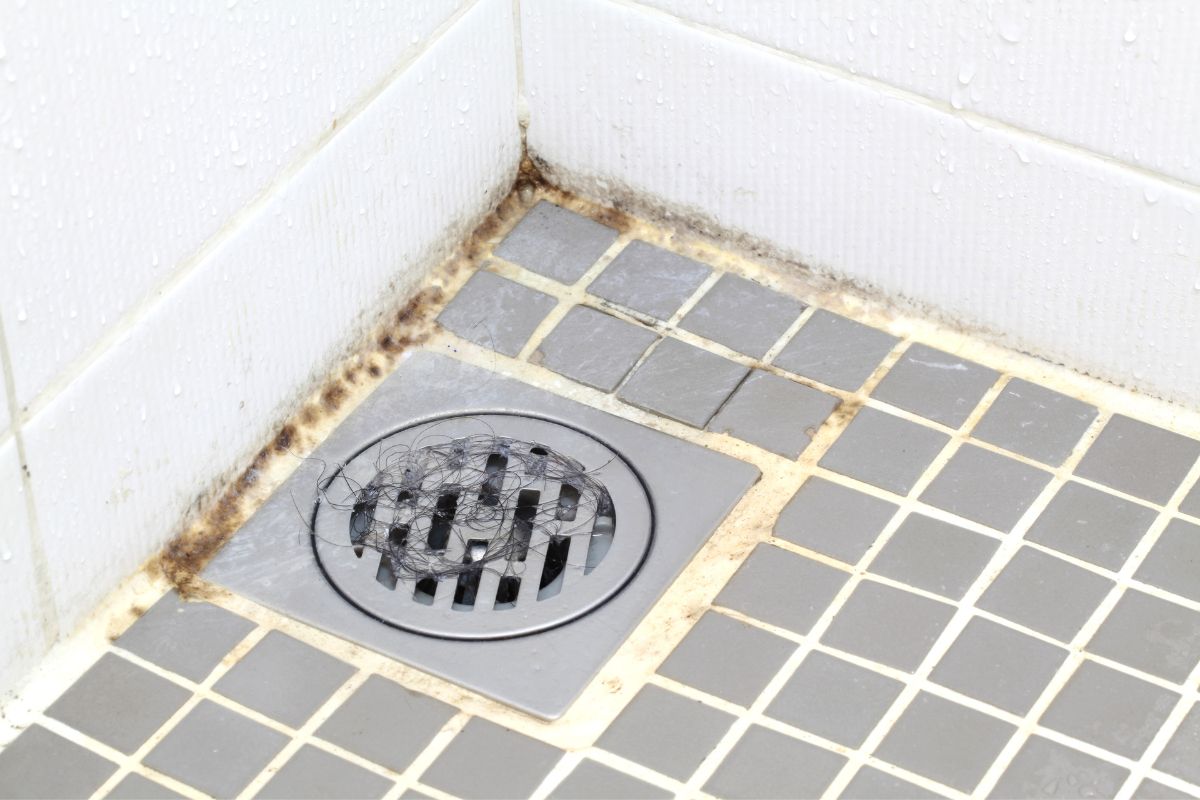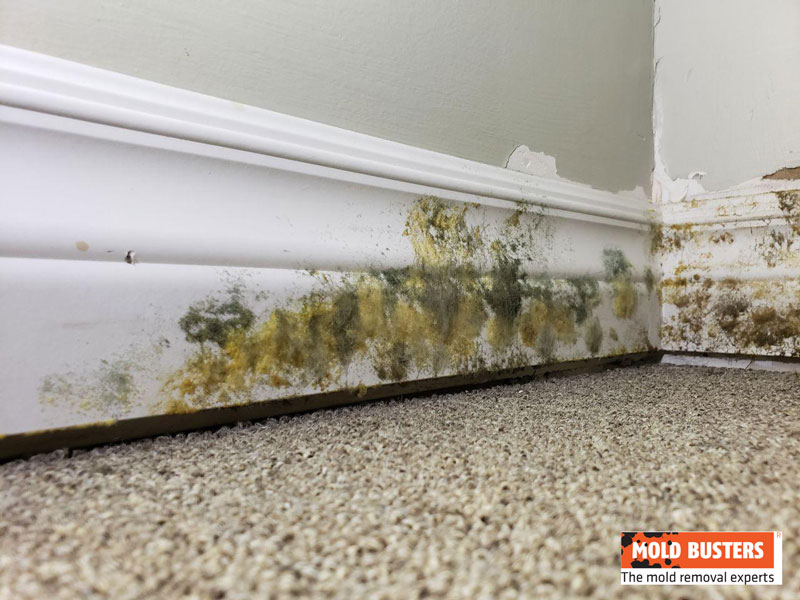Identifying Yellow Mold: Yellow Mold In Bathroom

Yellow mold in a bathroom is a common problem that can affect both the aesthetics and health of your home. It can appear in various forms and locations, and understanding its characteristics is crucial for effective removal and prevention.
Appearance and Texture of Yellow Mold
Yellow mold, as its name suggests, is typically characterized by a bright yellow or yellowish-green color. It can appear in various forms, including fuzzy, powdery, or slimy. Its texture can range from soft and velvety to hard and crusty, depending on the type of mold and its growth conditions.
Common Types of Yellow Mold in Bathrooms
Several types of mold can appear yellow in bathrooms. Here are some common examples:
- Aspergillus: This type of mold is known for its yellow or greenish-yellow color and can produce a variety of toxins. It thrives in warm, humid environments, making bathrooms a prime location for its growth.
- Penicillium: This mold is often found in bathrooms and can also be yellow or greenish-yellow. It is known for producing penicillin, an antibiotic, but can also cause allergic reactions in some individuals.
- Cladosporium: While Cladosporium is more commonly known for its dark green or black appearance, it can also appear yellow or brown. It is a common mold found indoors and can thrive in damp environments, including bathrooms.
Identifying Yellow Mold
It is important to distinguish yellow mold from other substances that may appear similar.
- Mineral Deposits: Hard water stains can sometimes resemble yellow mold, but they are typically harder and more crusty. They can also be easily removed with a cleaning agent.
- Rust: Rust is another substance that can appear similar to yellow mold, but it is typically reddish-brown in color and can be removed with a rust remover.
- Dirt or Debris: Accumulated dirt or debris can sometimes appear yellow, but it is usually less concentrated and more easily wiped away.
To confirm the presence of mold, consider the following:
- Visual Inspection: Carefully examine the area in question for the characteristics of mold, such as its color, texture, and growth pattern.
- Smell: Mold often has a distinctive musty or earthy odor. If you detect this smell, it is a strong indication of mold growth.
- Spore Test: If you are unsure about the presence of mold, you can purchase a mold spore test kit from a hardware store or online. These kits can detect mold spores in the air and provide a more definitive diagnosis.
Causes and Risk Factors

Yellow mold, a common sight in bathrooms, thrives in damp environments. Understanding the causes and risk factors associated with its growth is crucial for preventing its presence and safeguarding your health.
Moisture and Humidity
Bathrooms are naturally susceptible to moisture and humidity due to showering, bathing, and other water-related activities. These conditions create an ideal environment for mold spores to germinate and proliferate.
The presence of moisture and humidity provides the necessary conditions for mold growth.
Poor Ventilation
Inadequate ventilation allows moisture to linger in the air, creating a favorable environment for mold growth. This can occur due to insufficient airflow, malfunctioning exhaust fans, or the lack of windows.
Leaks and Spills
Leaks from pipes, faucets, or appliances can lead to water damage, providing a constant source of moisture for mold growth. Spills and water splashes can also create damp spots on surfaces, fostering mold development.
Inadequate Cleaning Practices
Neglecting regular cleaning can allow mold spores to accumulate and grow unchecked. Failing to remove mold spores and moisture from surfaces provides a breeding ground for yellow mold.
Health Risks Associated with Yellow Mold
Exposure to yellow mold can pose health risks, particularly for individuals with respiratory issues, allergies, or weakened immune systems.
Yellow mold can trigger allergic reactions, including sneezing, coughing, itchy eyes, and skin irritation.
Exposure to yellow mold can also lead to respiratory problems such as asthma, bronchitis, and lung infections.
Common Risk Factors
Several factors contribute to the development of yellow mold in bathrooms:
- Lack of ventilation: Poorly ventilated bathrooms trap moisture, allowing mold spores to flourish.
- Water leaks: Leaking pipes or faucets provide a constant source of moisture for mold growth.
- High humidity: High humidity levels in bathrooms create an ideal environment for mold spores to germinate and multiply.
- Lack of regular cleaning: Regular cleaning removes mold spores and prevents their accumulation.
- Improperly sealed showers and tubs: Gaps and cracks in shower enclosures or tubs allow water to seep into surrounding areas, creating damp spots where mold can thrive.
Removal and Prevention

Getting rid of yellow mold in your bathroom requires a combination of thorough cleaning and preventative measures to stop it from coming back. This section will guide you through the process of effectively removing existing mold and implementing strategies to prevent future growth.
Removing Yellow Mold
Removing yellow mold involves a two-pronged approach: cleaning the affected surfaces and disinfecting to kill the mold spores.
- Prepare the Area: Before starting, wear protective gear like gloves, a mask, and eye protection to prevent exposure to mold spores. Open windows and doors to improve ventilation and reduce the risk of inhaling spores.
- Cleaning: Use a stiff-bristled brush or a cleaning solution to scrub the affected areas.
- Disinfecting: After cleaning, apply a mold-killing solution to disinfect the surfaces.
- Drying: Thoroughly dry the affected areas using a fan or dehumidifier. Mold thrives in damp environments, so ensuring complete dryness is crucial.
Effective Cleaning Solutions
Several cleaning solutions are effective in removing yellow mold:
- Bleach Solution: Mix one part bleach with ten parts water. This solution is highly effective against mold and mildew. Apply it to the affected area and let it sit for ten minutes before scrubbing and rinsing.
- Borax Solution: Combine one cup of borax with one gallon of water. This solution is a natural disinfectant and can be used on most surfaces. Apply it to the affected area and let it sit for at least 30 minutes before rinsing.
- Vinegar Solution: Mix equal parts vinegar and water. Vinegar is a natural mold killer and can be used on non-porous surfaces. Apply it to the affected area and let it sit for at least 30 minutes before rinsing.
- Commercial Mold Cleaners: Many commercially available mold cleaners are effective in removing mold. Choose a cleaner specifically designed for bathroom surfaces and follow the manufacturer’s instructions.
Preventing Future Mold Growth
Preventing future mold growth requires addressing the underlying causes of moisture and humidity. Here’s a comprehensive guide to preventing yellow mold in your bathroom:
- Ventilation: Ensure adequate ventilation in your bathroom by using an exhaust fan during and after showering or bathing. This helps remove excess moisture and humidity.
- Moisture Control: Address any leaks or water damage promptly. Fix dripping faucets, leaking pipes, and clogged drains to prevent water accumulation.
- Regular Cleaning: Clean your bathroom regularly, especially surfaces prone to moisture, such as shower walls, floors, and grout.
- Proper Storage: Store items like towels, washcloths, and bath mats properly to allow them to dry completely. Avoid storing items in damp areas.
- Dehumidifier: Consider using a dehumidifier, especially in humid climates or if you have persistent moisture problems.
Yellow mold in bathroom – Yellow mold in the bathroom can be a sign of excess moisture, which can be exacerbated by cluttered surfaces. To combat this, consider implementing a stylish storage solution like those offered by urban outfitters bathroom storage. These storage solutions can help you keep your bathroom organized and dry, reducing the chances of mold growth.
Yellow mold, a common sight in bathrooms, thrives in damp environments. It can be particularly troublesome in areas with poor ventilation, such as the women’s bathroom toilet where moisture often lingers. Regular cleaning and ensuring proper airflow are crucial to combatting this unsightly and potentially harmful growth.